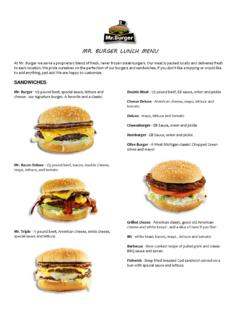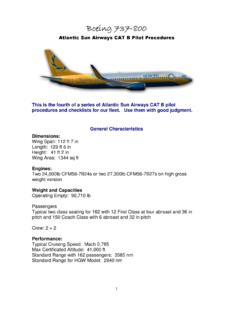Transcription of Consumer Behavior - Utility Theory
1 Consumer Behavior - Utility Theory At this point we want to start examining the economic decision-making of individual entities in the economy. That is, individual consumers, households, firms, and industries. This is really the start of Microeconomics. Although it takes both D & S to make a market and to determine a price level, it is often felt that it is consumers, those entities whose decisions are reflected by demand, who are the major driving force in the market. This belief tends to have some validity since if you consider it for a moment you'll realize that we tend to focus more on consumption at various stages in our lives than we do on production. When you are very young and very old you are more of a Consumer than a producer. It is during that middle part of your life that you are, in general, the most productive. Therefore we'll start by looking at the demand side of the market. We will examine Consumer Behavior and develop a model that shows:1.) How consumers make consumption decisions; that is, how they determine what portion of their income to spend on various ) Why the demand for some G/Ss is more elastic than the demand for other , we will be developing a model of Behavior that explains DEMAND and the rationale behind the downward sloping D curve.
2 This is termed Utility is a somewhat abstract concept. What you buy/consume depends partly upon your preferences/tastes (and also on resource constraints).You want what a G/S provides - the satisfaction of some want - not the actual G/S is simply a method of ranking/ordering your preferences. Preferences are themselves anintangible concept, but in general wouldn't you agree that your preference for a certain good is linked in a positive way to the amount of satisfaction that you derive from the consumption of that good?Earlier we used the term Utility to denote the satisfaction of wants. Additionally, we made the assumption that: "man is a rational self-interested Utility maximizer".Basically then, what we are going to do is examine how you expend your resources so that your Utility is maximized. This discussion assumes that you can't affect prices!And, since earlier we noted that because of scarcity consumers can't have everything that they want we'll have to maximize Utility subject to constraints.
3 These constraints are our budget and prices. This model then is going to take into consideration 3 things:Income, Prices and Consumer preferences ( given by Utility comparisons).Most discussions of Utility at this level use a numerical measure of Utility . This is fine as a pedagogical tool but there are a lot of caveats that should be ) Utility CANNOT BE MEASURED IN AN ABSOLUTE SENSE! That is, you cannot measure it quantitatively/numerically. How much satisfaction/benefit do you get from the consumption of some good such as your favorite beverage? Can you give me some numerical magnitude that has meaning? I can't. You can indicate the order of your preference, you can state that goodx P goody. You can measure it in an ordinal sense such as 1st., 2nd. etc. So why do we express Utility quantitatively? Because it facilitates the explanation of the concept of MU. But remember that any numbers used here are essentially plucked out of the air. They are only ) Utility IS SUBJECTIVE AND CAN CHANGE OVER TIME.
4 What gives one person a lot of satisfaction may not give another person the same satisfaction. And you may not get the same amount of satisfaction in the future as you do now. EXAMPLE: CLOTHES; They go in and out of are 2 measures of Utility that we need to define and Utility (TU) - The total amount of satisfaction received from all units consumed of a Utility (MU) - The change in total Utility from consuming one more unit of a is used here in the same sense as TU Q TU= MULet's take an example:Assume that you are given:# of diet Coke Consumed Utility of each then you have TU & MU 0 - 0 - 1 10 10 10 2 15 25 15 3 8 33 8 Clearly you would not consume the 2nd. Diet coke which has 15 units of satisfaction after the first which only has 10 units thus the order of consumption is relevant or the ranking of the additional Utility of another unit consumed, be it the 2nd., 3rd., 4th., or whatever, have to be >, <, or the same as the Utility of the previous unit?
5 Normally, if a good can be used to satisfy more than 1 want, you would use the first unit to satisfy the greatest want first and any successive units to satisfy lesser wants. For example: You are stranded in the desert, you are filthy and you are dying of thirst. A rescuer arrives and gives you water. Would you drink or wash first? You would probably drink the first few units until you were no longer thirsty and then if there were any remaining units you would then wash! The implication is that succeeding units satisfy lesser wants or that you get lesser Utility from succeeding gives us the: LAW OF DIMINISHING MARGINAL Utility - the MU gained by consuming equal and successive units of a G will eventually decline as the amount of a G consumed increases - all other things held things to note about MU and TU:1.) as long as MU > 0, then TU is increasing;2.) when MU < 0, then TU is decreasing. Does it make sense to stop consuming then when MU = 0 unless you are constrained prior to this point?
6 YES!!One of our goals here is to determine how we maximize Utility subject to our income and price constraints and in the process see if we can determine a general rule for this that will also tell us how much of a particular good a Consumer will develop this let's again take an example: Assume that there are only two goods to which we allocate our budget. Slices of Pizza (P) and Gyros (G). Pp = price of pizza slice; Pg = price of a gyro;Assume that the budget is entirely we want to max U Budget = P(Pp) + G(Pg). What do we need to know?Budget = $10; Pp = $2/slice; Pg = $2 each And we'll need some MU schedules.# of pizza slice MUp # gyro MUg110112 Note that this is a schedule of MUs and thus it gives MU of that particular unit and not of that NUMBER of units!!2828363344425251 TUpizza = 30 TUgyro = 26We could spend our entire budget purchasing just pizza slices or just gyros since either wouldcompletely deplete our budget. However a rational Consumer would not choose to purchase just 5 gyros because the TU of 5 gyros = 26 < 30 = TU of 5 pizza slices.
7 The question is then whether there is some other alternative that would provide an even greater amount of TU. Is there some other combination of units or possible choice that would improve our situation. One way to do this is to start with the good that has the highest MU for the 1st. unit and then continueselecting that unit of whichever good has the highest MU until we've exhausted our budget. That is:BUYMUAMT. SPENTAMT. 10262nd. pizza (or G) 8242nd G (or P)8223rd. pizza620 Totals4410 Since our budget is exhausted and TU = 44 we have clearly improved our position and maximized TU by choosing a rule that says simply select that unit that has the highest MU and repeat this until the income is this work in all cases? What happens if prices aren't equal?What if Pg = $1? MUs haven't changed. However, if we buy the combination that maximized our Utility when Pg = $2, we'll have TU = 44 and we'll have $2 left. According to the decision rule we used above we would then select the 4th.
8 Slice of pizza, giving us TU = 48 and depleting our budget. Is TU maximized now? And clearly the answer is no since we could expend the $2 on the consumption of the 3rd. and 4th. gyros and we would get 5 additional units of Utility instead of 4 units. Thus in this case with Pp = $2/slice and Pg = $1 each, we would maximize TU at 49 by consuming 3 slices of pizza and 4 gyros. Thus using a decision rule of simply picking the next unit based upon which unit has the highest MU will not always lead us to TU is the source of the problem? It is the fact of unequal prices. We really aren t comparing similar units. To put everything on an equal footing we need to express them in equal unitsso let's do it as MU per $ spent. That is divide MU by Price to get MU per $; MU/P. So now let us add a MU/P column to our above table and we get:# of pizza slice MUp MUp/Pp # gyro MUg MUg/Pg110511212284288363333442422521511 Now let the decision rule be to select the next unit that has the highest MU per $.
9 In this case we would select them in the following order:BUYMUAMT. SPENTAMT. 8181st. pizza 10262nd pizza8243rd. pizza6223rd. gyro3114th. gyro210 Totals4910 Using this method and the original prices what would be the outcome? The same solution that we originally we use this information to develop a general rule? YES!!How are we making our selection? We are comparing MU/P (MU per dollar).At the last unit consumed - when you have exhausted your budget - there are 3 possible situations that could exist. Between any 2 goods A and B you could have: Case #1 Case # 2 Case #3 MUaPa>MUbPb OR MUaPa=MUbPb OR MUaPa<MUbPbIn the first case you get greater Utility per $ by consuming good A. So to maximize your Utility you would want to buy another unit of A which would mean that:A.) you would have to buy less of B since the budget is ) the next unit of A would have a lower MU/P and the previous unit of B would have a higher # 3 is essentially the reverse of this with B providing the higher MU/P; you are getting less Utility per $ by consuming A so you would want to buy less of A.
10 In either situation you want to consume more of that good that has the higher MU/P (and thus less of the good that has the lower MU/P) until this situation no longer is, to maximize total Utility , you consume that combination of G/Ss such that it is impossible to get more TU by consuming more of one good and less of does that leave you? At the point where MU/P are equalized across all goods. Thus we can state our general rule for TU maximization as:TU is maximized when:MU1P2=MU2P2=..=MUnPn and all income is spent. Or, whenall income is spent and while MU1P1>MU2P2 , buying more of good 1 and less of good 2 will not increase entire statement is what we refer to as Consumer Equilibrium. Clearly we need the last part of this statement to cover situations like our last example where TU is maximized and MU/P isn t equalized. This demonstrates several things: 1.) the concept of marginal analysis; although we were maximizing TOTAL Utility it was the marginal aspects of the situation that led to the important generalization about TU ) it shows why DEMAND is downward sloping and also how you can derive a demand curve.



